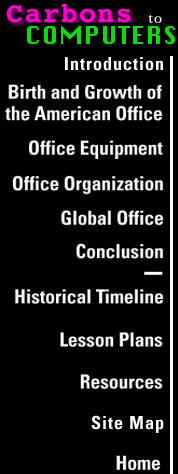
A Short History of the Birth and Growth of the American Office
The locally oriented American economy of the early 1800s did not need offices as we know them today. Business was run then much as it had been run for half a millennium. Goods were made, transported, and sold. With the help of a few clerks, merchants ran their small companies as family businesses. Few differences distinguished the merchants in early-nineteenth-century Boston from those in thirteenth-century Florence.
The early nineteenth-century merchant was his own importer, exporter, banker, wholesaler, retailer, and possibly shipowner. All businesses--even export businesses--were local. The merchant himself oversaw every aspect of his business, and his clerk posted his accounts in a ledger book or copied out his correspondence to a buyer. Even if he was a very successful merchant, or ran a large textile mill, he had no more than three men helping him with administrative tasks.
With the arrival of the railroad, however, the general merchant's business and the entire nature of American commerce changed forever. The railroad not only united the states, changed how and where we lived, and dramatically altered the country's image, it also transported goods almost anywhere. Suddenly, coal and the steam engine made it possible for business fortunes to increase as rapidly as they could be expanded westward. Using the railroad, local businessmen could do business nationally. And they could no longer do their business in their heads. Once the stakes for business increased, so did the logistics.
